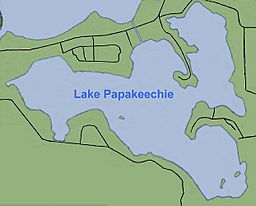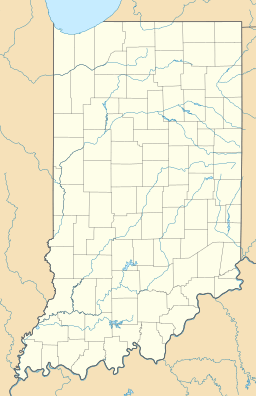Lake Papakeechie facts for kids
Quick facts for kids Lake Papakeechie |
|
|---|---|

Diagram of Lake Papakeechie
|
|
| Location | Kosciusko County, Indiana |
| Coordinates | 41°22′21″N 85°40′13″W / 41.3726°N 85.6702°W |
| Type | reservoir |
| Catchment area | 5.36 sq mi (13.9 km2) |
| Basin countries | United States |
| Surface area | 179 acres (0.72 km2) |
| Surface elevation | 863 feet (263 m) |
Lake Papakeechie is a smaller lake in Kosciusko County, Indiana, United States. It covers about 179 acres (0.72 square kilometers). This lake is man-made, meaning people created it. It sits just south of a larger lake called Lake Wawasee and its water flows into Lake Wawasee. The Papakeechie Protective Association owns and takes care of the lake.
Contents
History of Lake Papakeechie
Lake Papakeechie gets its name from a very important Miami chief named Papakeecha. He was also known as Pa-hed-ke-teh-a. Chief Papakeecha was a powerful leader in the area around Lake Wawasee.
How the Lake Was Created
Lake Papakeechie was formed around 1910. Before it became one big lake, this area had six smaller lakes. These little lakes were called Jarret's, Gan's, Hooper's, and three named Hartzell's. Long ago, in the early 1800s, people built a fish trap where the water flowed into Lake Wawasee. This made it easy to catch fish.
The idea to create a larger lake came from Charles A. Sudlow of Indianapolis. He built an 8 foot (2.4 m) tall earthen dam on the north side of the area. When the dam was finished in 1913, the water level rose. This caused a lot of plants to float up. Workers then loaded these plants with rocks, poked holes in them, and sank them to the bottom.
Homes Around the Lake
In 1931, there were about 69 homes around Lake Papakeechie. Today, there are nearly 400 houses, with about 300 right on the lakefront. Some undeveloped areas are still owned by individuals. The land lots, which were about 50 feet (15 m) wide, were sold for $500 each. The 5 miles (8.0 km) of shoreline was known as a great spot for fishing.
The Legend of the Lakes
An old legend tells a story about three small Native American tribes. They lived around the biggest lake in the region. The largest tribe, led by Chief Wawasee, lived on Conklin Hill, which overlooked the lake.
Chief Flatbelly and his people settled on a peninsula to the north. The youngest and bravest chief, who had the smallest tribe, had to live on the hills. He fished in the little lakes next to the big one, to the south.
When the first map of the area was made, the two main lakes looked like a turkey with a huge head. The streams looked like whiskers. Because of this, the area was first called Turkey Lake. The legend says that as more summer homes were built, the spirit of Chief Wawasee returned. He "ate up the turkey" and gave his name to the big lake, making it famous forever.
Sudlow's Dream
The area around the six small lakes had high hills, deep holes, swamps, and sharp ridges. The deep holes were full of water and fish, but it was hard to reach them.
Charles A. Sudlow had a dream of creating a "Sportsman’s Paradise." He formed a company called The Northern Indiana Improvement Company. This company bought all the land in and around the valley with the small lakes. They built several dams, totaling about 1,900 foot (580 m) in length. They also dug wells around the valley to tap into underground water sources. This created a beautiful lake with clear water, about nine feet higher than Lake Wawasee.
More than 600 acres (240 ha) of land was bought, and 325 acres were covered by the new lake. The hills became islands, and the ridges offered many great spots to build homes. Lake Papakeechie gets its water from the surrounding hills and underground sources. A constant stream flows from it into Lake Wawasee.
Fish Hatcheries
In 1914, the State Commissioner of Fisheries and Game noticed that enough water flowed from Papakeechie into Wawasee to raise fish on a large scale. The state leased a 4 acres (1.6 ha) piece of land from Sudlow's company for fish hatcheries. They also bought more land below the dam.
They built 12 ponds, each about half an acre. Water from Papakeechie flowed into these ponds, stepping down about 4 feet (1.2 m) at a time. When needed, the water would drain into Lake Wawasee. This created a perfect system for hatching freshwater fish. The state agreed to maintain the dams and pay rent by providing 5,000 young bass fish each year. They also shared other fish hatched there. Because the lake is privately owned and people are not allowed to fish there, fish like bass, crappies, and bluegills became very plentiful.
The Papakeechie Corporation
When Charles A. Sudlow passed away in 1915, his estate was managed by a Trust Company in Indianapolis. For six years, Lake Papakeechie remained quiet. In 1921, the Northern Indiana Improvement Company sold the property to Thomas J. Prickett. He then sold it to the Papakeechie Corporation, a new company formed to take over the lake.
The corporation divided the land around the lake into lots for summer homes. They made sure to police the lake with a careful caretaker. They paid taxes on the land under the water and around it, making it a private lake. In 1923, over 200 acres (81 ha) of land owned by the company were still undeveloped and not for sale. Many wild ducks were seen there. The corporation sold nearly 100 lots in its first year.
In 1923, you could only reach Lake Papakeechie by train to Wawasee, and then by boat. The corporation started building roads around the lake, planning a boulevard that would surround it.
Papakeechie Mystery
From the 1950s to the late 1960s, a large aluminum airplane wheel with a tire was found on the shore of Papakeechie. It was about 7 to 8 feet (2 meters) across. It lay just east of the dam. No one ever figured out how this piece of landing gear got there. It would have been very hard to roll it uphill and over the dam. Some people thought it might have been dropped from an airplane, but this was never proven.
Lake Characteristics
Lake Papakeechie has a drainage area of about 5.36 sq mi (13.9 km2). The dam is 2,460 feet (750 m) (749 meters) long. It can release a maximum of 291 cubic feet per second (8.2 cubic meters per second) of water. The normal amount of water stored in the lake is about 890 acre-feet (1,100,000 m3). The Indiana Department of Natural Resources (DNR) is the state agency that regulates the lake.
The Papakeechie Protective Association and the Indiana DNR had some disagreements in the past. The DNR believed the Association's dam and levees were old and unsafe. They said these structures did not follow state laws. The DNR even threatened to break the dam if the Association did not fix it. Experts estimated the repairs could cost up to $800,000. However, in 2012, the Association successfully rebuilt their levee system, and the State of Indiana was satisfied.
Chief Papakeechie
Chief Papakeechie, whose full name was Pa-hed-ke-teh-a, was a very important Miami chief. His name means "Flat Belly." When white settlers first arrived, he was about sixty years old. People described him as having dark copper-colored skin and being a bit heavy. He often wore a silver ring or a fish bone through his nose. He was the brother of another chief named Wau-wa-aus-see. Like many chiefs in the area, he said he fought in the Battle of Tippecanoe.
In 1828, Chief Papakeechie was given a reservation of land, which was six miles by six miles, totaling thirty-six square miles. He returned this land to the government in 1834. The western border of his land almost cut through Lake Wawasee. Today, places like Our Lady of the Lake Seminary and the South Shore Inn are just inside the western edge of his old reservation. His village and a brick house built for him by the government were about a mile and a half northwest of Indian Village in Noble County. Sometimes, pieces of brick from his old house can still be found in a nearby field.
After 1834, Chief Papakeechie's entire reservation became part of a huge land grant (one and a half million acres) given by the government for the Wabash and Erie Canal. This land was later sold, and the money was lost in that failed project. Chief Papakeechie died between 1838 and 1840. His burial ground, where he rests with many of his villagers, can be found by following Road 8 east from the northeast corner of Lake Papakeechie. Near where the road turns north, there is a low, swampy woodland. Just beyond its southeast corner, on higher ground, is the cemetery, now only marked by slight bumps in the earth.
Books About Papakeechie
- Giese, Vincent J., Lead Thou Me on: Reflections from Lake Papakeechie. Our Sunday Visitor, Huntington, Indiana, U.S.A., 1993.
- Leffers, Laura. Dance on the Water. Book World/Blue Star, 1996. ISBN: 1-881542-10-6, ISBN: 978-1-881542-10-0.
- Lilly, Eli. Early Wawasee Days. Indianapolis: Studio Press Inc., 1960.



